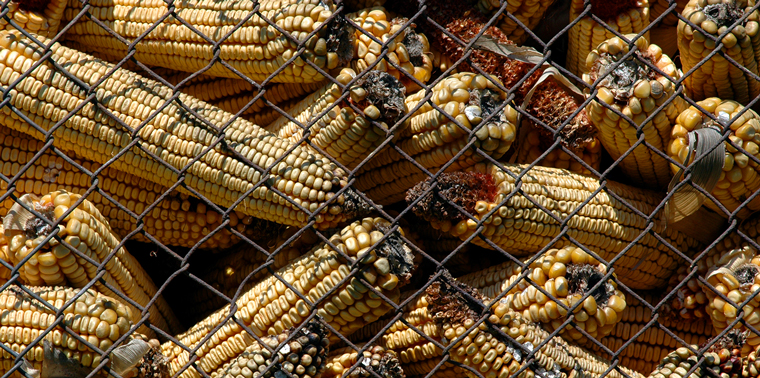December 27, 2017 — In the Global South, hundreds of millions of people are exposed to mycotoxins — deadly compounds produced by fungi growing on food.
Mycotoxins raise the risk of cancer and, at high doses, can kill their victims. They’re made by mold growing on staple foods like nuts, corn and other grains. Experts are concerned that climate change is helping the molds thrive.
A recent report from the United Nations’ International Agency for Research on Cancer outlined more than a dozen potential strategies for intervention. Most of the strategies require further research before they can be deployed — but here are four ready to go right now.
More Diverse Diets
Mycotoxins don’t affect all crops equally. Corn and groundnuts, for example, are more commonly contaminated than staples such as rice, sorghum and millet. Eating mold-prone foods less often, and consuming alternatives instead, can reduce mycotoxin exposure.
Dietary diversity is no simple goal: Shifting people’s food preferences presents a substantial social challenge even when communities possess economic power. But the true trap is poverty, since more money means the capacity to buy a wider range of foods.
Discarding Contaminated Crops
Farmers, villages and others can take action in the post-harvest stage of food production, including by sorting contaminated and uncontaminated crops. Studies of corn in Africa show that villages can cut the concentration of mycotoxins by removing moldy grains.
To improve sorting in the Global South, the report recommends training rural women to effectively hand sort. Equipment for automatic sorting could also help: Commercial nut farmers in developed nations employ electronic optical sorters, for example, but such technology remains out of reach for many agricultural operations worldwide.
Food security poses one of the most pernicious obstacles to using this approach, especially in Africa. When food is scarce, people are not inclined to throw out parts of their harvest.
Nixtamalization
Cooking and soaking cornmeal in limewater or a similar substance, a process called nixtamalization, breaks down some mycotoxins.
It’s common in Central and South America, though efficacy varies depending on the exact process. Nixtamalization has yet to be adapted for Asia and Africa.
Better Storage
Mold can grow on crops even after they’ve been harvested. A number of factors can cause accumulation of mycotoxins, including hot temperatures, high humidity, insects, rodents, crops being dried inadequately and water seeping into crop storage.
Improving agricultural storage can mitigate many of these issues. Crops dried more quickly after harvest are less likely to grow much mold, and storage facilities that are clean and dry can also help keep mycotoxins at bay. Other interventions, including proper water drainage, also help.
Research validates each of the four interventions, but resources are needed to put them into practice.
“As currently envisaged,” the report says, “the recommendations would be relevant for investment of public, nongovernmental organization, and private funds, at the scale of the subsistence farmer, the smallholder, and through to a more advanced value chain.” ![]()
Ensia shares solutions-focused stories free of charge through our online magazine and partner media. That means audiences around the world have ready access to stories that can — and do — help them shape a better future. If you value our work, please show your support today.
Yes, I'll support Ensia!
